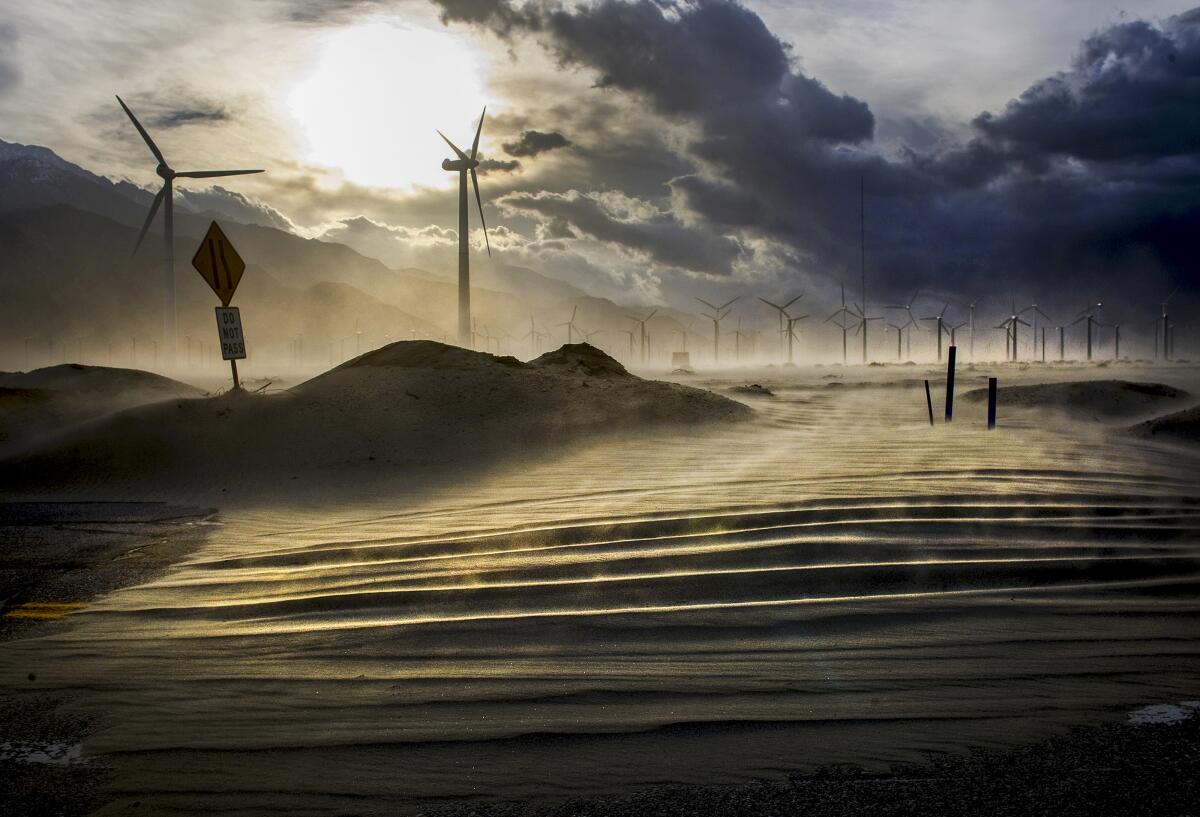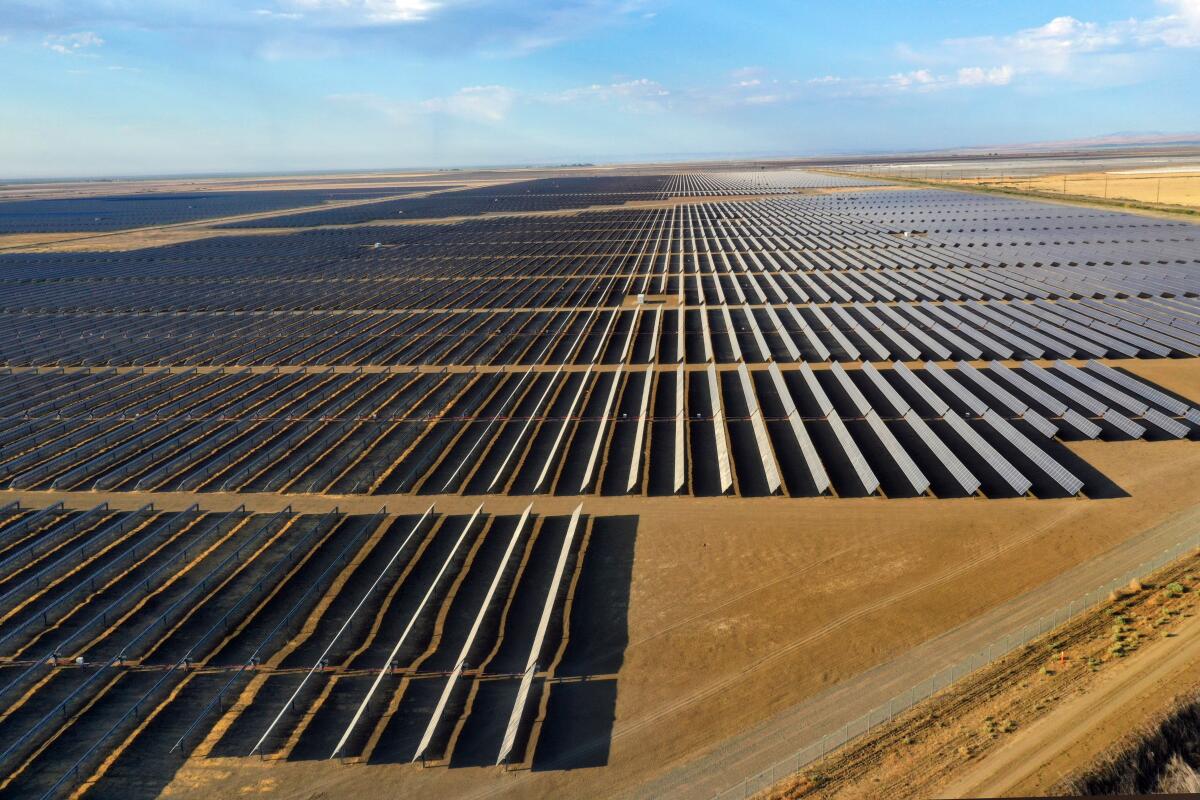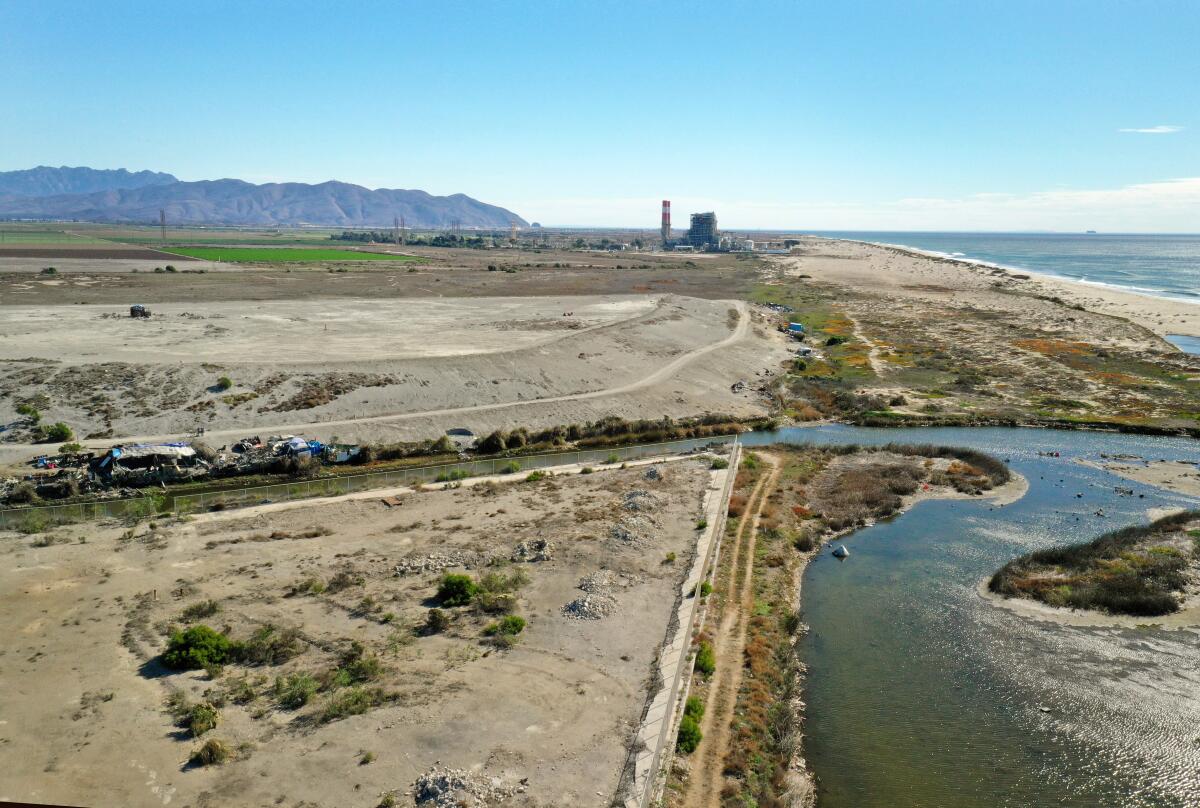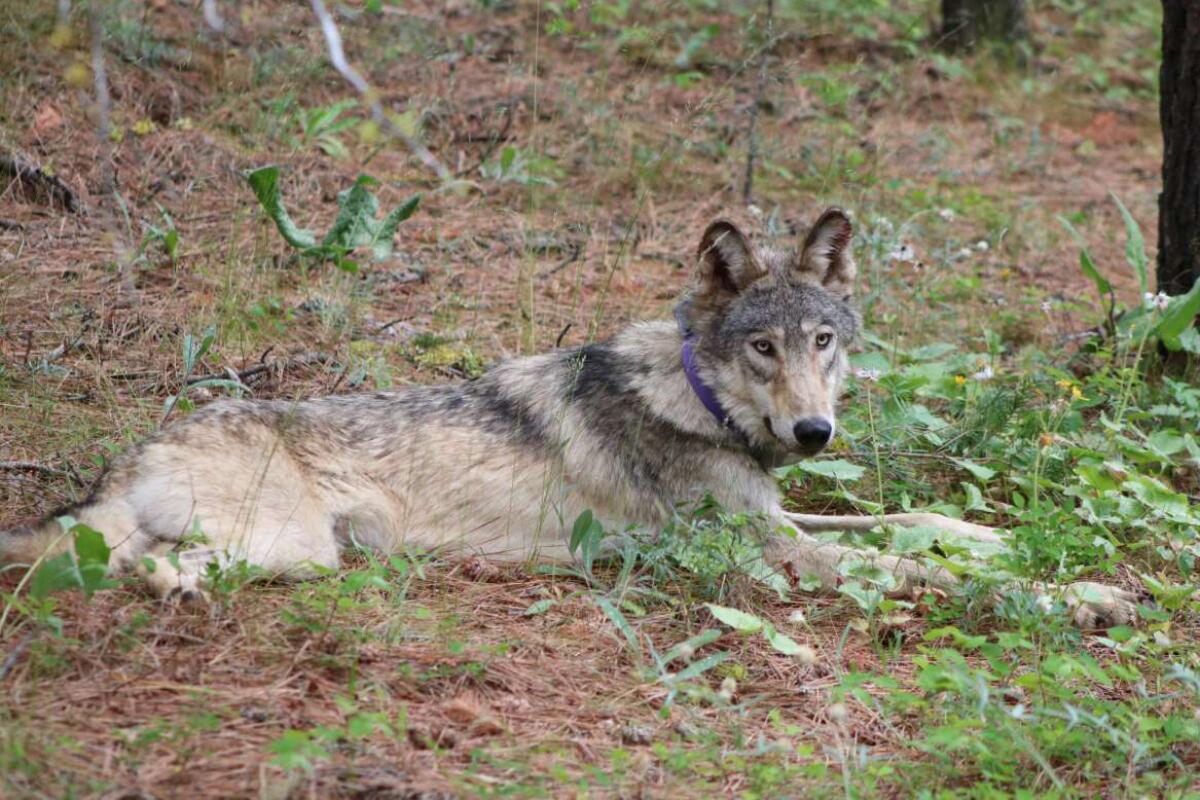Newsletter: Biden is leasing public lands for oil drilling. But what about solar and wind?
- Share via
This is the Dec. 2, 2021, edition of Boiling Point, a weekly newsletter about climate change and the environment in California and the American West. Sign up here to get it in your inbox.
One of Joe Biden’s boldest campaign promises was to end fossil fuel leasing on public lands and waters. The federal government would no longer auction off the right to drill for climate-damaging oil and natural gas across the American West, candidate Biden told voters. Officials might even stop issuing drilling permits on lands that oil and gas companies had already leased.
A year after the election, that promise is far from reality.
The federal Bureau of Ocean Energy Management held a massive sale of leases in the Gulf of Mexico last month, and the Bureau of Land Management has scheduled several onshore auctions for the first quarter of 2022. President Biden also ordered the release of 50 million barrels of oil from the Strategic Petroleum Reserve in an effort to slow the rise of gasoline prices.
To be fair, Biden’s Interior Department temporarily paused fossil fuel leasing, only for a federal judge to reject the pause as illegal. But many climate advocates weren’t pleased with a report released by Interior Secretary Deb Haaland last week that called for modest limits on federal oil and gas leasing rather than an outright ban and hardly said anything about climate change.
But what about Biden’s other energy promise for America’s public lands — that his presidency would be a boon for the construction of solar and wind farms, which would create jobs and tax revenues and limit the need for fossil fuels?
The president’s track record there is mixed at best, at least so far.

The Bureau of Land Management — which oversees nearly 250 million acres of public lands, or about one-tenth of the country’s surface area — has approved just one solar farm since Biden took office. It hasn’t approved a single wind farm. The agency has also signed off on three geothermal power plants, which can produce climate-friendly electricity around the clock.
For some perspective, I called up Peter Weiner, a San Francisco-based attorney who represents solar developers trying to get projects built on public lands across the West. Overall he had positive things to say about political appointees and career staff at the Bureau of Land Management, and their efforts to issue permits for renewable energy. He said he expects the agency to approve three more solar farms in the next month, all in California’s Riverside County, south of Joshua Tree National Park.
I asked Weiner whether he thinks the Biden administration is on track to meet a congressional target of permitting 25 gigawatts of renewable energy on federal lands by 2025. He thinks they’re behind, but he’s hopeful that approvals will start to come faster.
“I’m cautiously optimistic that things are going to change, but goddamn they’re slow to change,” he said.
What’s the holdup, exactly? Weiner pointed to staffing shortages spurred by President Trump’s half-baked plan to move Bureau of Land Management headquarters to Colorado, which led to an exodus of employees. Getting political appointees in place during the Biden administration’s first year hasn’t been a quick process, either. Weiner told me that when he’s talked with some of the president’s top appointees on public lands policy, he’s learned they have meetings scheduled every half-hour the entire day.
“How much can you get done when you’re spread that thin?” he asked.
I also talked with Tom Vinson, vice president for federal regulatory affairs at the American Clean Power Assn., a trade group for solar and wind power companies. He said the challenges with building renewable energy on public lands predate the current administration, and it’s too much to expect Biden’s team to eliminate those obstacles in less than a year.
Still, Vinson is optimistic that changes are coming. He pointed out that the Bureau of Land Management recently issued a call for suggestions to improve renewable energy permitting, to which his group responded with several ideas for easing barriers. He also pointed out that, despite the small number of public lands projects the Biden administration has approved so far, federal officials are moving forward with the environmental analysis for at least wind one farm in Idaho, as well as several solar projects.
“They are trying to make projects work, both wind and solar. At the same time, they’re trying to improve the underlying process by which projects are permitted,” he said. “We are optimistic that they understand the potential for renewables on public lands, and want to capture that and recognize that there are barriers to doing so under the current rules.”
I should stop here and state that blindly approving every renewable energy facility a developer wants to build on public lands is not a good idea. As I’ve written previously, solar and wind farms can destroy sensitive ecosystems, which is one reason many clean energy advocates prefer rooftop solar panels to sprawling solar farms. There’s a difficult-to-navigate tension between building much-needed renewable power plants to prevent climate catastrophe and protecting biodiversity and wild landscapes.
The one solar farm the Biden administration has approved thus far — the 2,000-acre Crimson project in California’s Riverside County, which could include 350 megawatts of solar and 350 megawatts of battery storage — helps illustrate that tension.

Before the Interior Department signed off on Crimson, the Center for Biological Diversity filed a protest, arguing that officials had failed to adequately study possible harm to desert tortoises, Mojave fringe-toed lizards and other creatures, including fragmentation of their habitat. The conservation group Basin and Range Watch also protested. So did the Colorado River Indian Tribes, which cited potential damage to Indigenous archaeological sites and the importance of desert wildlife to tribal culture and religion.
Mark Squillace, a professor of natural resources law at the University of Colorado Law School, suggested that smarter, more efficient federal land use planning could help get solar and wind farms built more quickly while minimizing environmental conflicts.
In a 2019 paper, Squillace proposed a new “layered planning” model in which the Bureau of Land Management would start by identifying its overall goals for an entire landscape — say, a watershed or wildlife corridor — and then work its way down to decisions about specific projects, such as a solar farm. That would cut down on cumbersome planning processes that can currently take a decade, while making it easier to assess the tradeoffs between renewable energy and conservation, Squillace told me.
“The current system is inefficient, and not necessarily the best, in terms of predicting the adverse impacts,” he said.
I reached out to the Biden administration for comment, asking the Interior Department what it has done to achieve Biden’s goal of promoting renewable energy on public lands and how they’d respond to criticism that they aren’t moving fast enough.
Tyler Cherry, the department’s press secretary, told me the Bureau of Land Management is currently processing applications for 36 solar projects, four wind projects and four geothermal projects, with preliminary review underway for an additional 64 solar and wind applications. He also pointed to the aforementioned call for suggestions on renewable energy permitting, saying officials are open to suggestions on issues such as the rent paid by developers and the amount of time it takes to process applications.
Cherry also sent me a written statement from Tracy Stone-Manning, director of the Bureau of Land Management. She said the Interior Department “is helping lead the all-of-government approach to meet the Administration’s ambitious renewable energy goals that will create jobs, boost local economies, and help address economic injustice.”
“As the climate crisis continues to impact our communities and our economic well-being, we are working to increase renewable energy production on public lands and waters,” Stone-Manning said. “At every step of the way, the Department will undertake these goals with broad engagement, including outdoor enthusiasts, sovereign Tribal nations, states, territories, local officials, agricultural and forest landowners, environmental justice advocates, and others.”
Cherry noted that the agency also signed off on the addition of battery storage to a previously approved solar project in Arizona, and five transmission lines that will support solar development in Nevada and Utah. The administration has seemingly been more focused on jump-starting the offshore wind energy industry, which could also go a long way toward phasing out fossil fuels.
America’s public lands are a lot of things to a lot of people. For me, they’re an amazing refuge for hiking and camping. For many Westerners, they’re a source of economic sustenance thanks to oil and gas, timber or grazing. For others, they’re perfect for off-roading, hunting or fishing. For endangered wildlife on a heating planet, they’re some of the last best places to survive.
It’s probably not fair to ask these special places to help solve the climate crisis, too. But we may not have much choice.
Here’s what else is happening around the West:
TOP STORIES

California’s Black and brown communities are five times more likely to be within half a mile of a toxic site that could flood as sea level rises. That’s a key finding from new research out of UC Berkeley and UCLA showing that more than 400 hazardous facilities across the state could be at risk of flooding, exposing nearby residents to dangerous chemicals and polluted water, my colleague Rosanna Xia reports. One of those at-risk communities of color is San Francisco’s Bayview-Hunters Point neighborhood, which is home to concrete plants, data centers powered by diesel generators and other industrial sites, and where a survey found that 86% of children developed severe asthma before starting kindergarten, as Elena Shao writes for Inside Climate News.
The American West went through climate hell in 2021, making it clear we’ve entered a dangerous new era of hotter heat waves, more brutal droughts and a growing threat of violent extremism on public lands. There’s still hope — but in a region mythologized for its rugged individualism, going it alone will be a recipe for disaster, as I write in a year-end wrap-up piece for The Times. Until then, we’ll continue to read stories like this one by my colleague Lila Seidman, about how flames from a recent fire moved so fast that officials hoping to use an experimental treatment to protect a grove of giant sequoias simply ran out of time.
It’s been a decade since California lawmakers created the “Rigs to Reefs” program to give fossil fuel companies an incentive to stop extracting oil and convert their offshore platforms to artificial reefs. But the program has been a failure thus far, with not a single company choosing to try it, Phil Willon reports for The Times. It’s a cautionary tale for elected officials and clean energy advocates pushing to end offshore production after the recent Huntington Beach oil spill. Speaking of, Amplify Energy is facing 14 lawsuits over the spill, my colleagues Connor Sheets and Laura J. Nelson report, although it’s not clear how much money anyone will be able to get out of the company, with one expert calling it “a zombie at this point.” At least the Orange County coast has now reopened to fishing, with officials determining this week the seafood is safe to eat, Nathan Solis reports.
DROUGHT CENTRAL
Cities and agricultural areas that depend on California’s State Water Project could receive 0% of their requested supplies next year as drought ravages the West. It’s the first time state officials have announced a 0% allocation since January 2014, although the number could go up later if winter brings decent rain and snowfall, the AP’s Kathleen Ronayne reports. In the San Joaquin Valley, meanwhile, well-drilling is already way up as farmers look to groundwater to grow their crops. But some have started taking steps to comply with California’s groundwater sustainability law, Dale Kasler and Phillip Reese report for the Sacramento Bee.
Researchers are taking mud samples from the floor of the Salton Sea to learn what kinds of toxic chemicals might blow into the Imperial Valley’s air as the lake recedes. The Times’ Louis Sahagún got his feet wet venturing into California’s largest lake with those researchers. In Utah, meanwhile, Circle of Blue’s Brett Walton reports that politicians hope to dam a northern valley and fill it with water from the Bear River — the main tributary of another shrinking body of water, the Great Salt Lake.
Water investment companies are purchasing vast amounts of farmland across rural Arizona counties, in hopes of one day selling the water to growing Phoenix suburbs. Reporting for the Arizona Republic, Ian James and Geoff Hing did some investigating and figured out which companies are buying and how much land they’re scooping up. Skeptics worry about rural communities drying up, but some farmers say they’ve worked the land for decades, and now it’s their right to profit off the water.
THE ENERGY TRANSITION
Pickup trucks are way bigger than they used to be, and no more fuel efficient than they were in the 1980s. That’s terrible for climate change and air pollution. It also means pickup truck drivers are being hit especially hard right now by high gas prices — and it might motivate some of them to go electric, my colleagues Russ Mitchell and Brian Contreras write. And for Californians hoping to one day travel between Los Angeles and the Bay Area via high-speed rail, some good news: California’s bullet train has survived a lawsuit arguing the state’s strategy for getting the project built in pieces is unconstitutional, Ralph Vartabedian reports.
Methane leakage in Utah’s oil and gas-producing Uinta Basin is some of the worst in the nation, with a leak rate of 6% to 8%, according to new research from the University of Utah. Here’s the story from Brian Maffly at the Salt Lake Tribune; for context, methane is an extremely potent greenhouse gas, and limiting leaks is one of the best ways to slow global warming. I’m also curious how this might affect L.A.’s plans to convert its Intermountain Power Plant in Utah from coal to natural gas. As Maffly reports, local politicians are annoyed that plant operators plan to source at least some of the gas from Wyoming instead of Utah.
While climate advocates like to talk about renewable energy replacing coal jobs, hardly any coal communities have seen significant renewable energy development. Biden’s “Build Back Better” bill would attempt to change that by offering tax credits to solar and wind companies that build where coal mines and coal plants have closed, Benjamin Storrow reports for E&E News.
AROUND THE WEST

The story of the gray wolf that ventured hundreds of miles from Oregon into Southern California came to an unfortunate end. After crossing several dangerous freeways in search of territory and mates, the wolf known as OR-93 was killed in a vehicle collision near Interstate 5, Louis Sahagún reports for The Times. It’s especially sad, one wildlife advocate said, because “a few feet away was a Shangri-La for wolves just waiting for him and an adventurous female to follow his path into the history books.”
New data on sediment buried at the bottom of Lake Powell show concentrations of lead, zinc, uranium and copper stemming from a legacy of mining, including the 2015 Gold King Mine spill. Details here from Zak Podmore at the Salt Lake Tribune. In better news, new research from the U.S. Geological Survey finds that most springs and wells in the Grand Canyon region of Arizona meet federal drinking water standards despite decades of uranium mining, as the AP’s Felicia Fonseca reports.
Why did the beloved clams of California’s Pismo Beach mostly disappear, and why are they maybe starting to come back? There are no clear answers, but my colleague Sean Greene has a beautiful tale of cute little bivalves, with photos by Carolyn Cole.
ONE MORE THING
Billy Barr has lived alone in an abandoned Colorado mining town high in the Rocky Mountains since the 1970s, taking snow data and making wildlife observations that have become increasingly valuable for researching climate and Western water supplies.
If that sounds more like folklore than reality, read this profile by the Washington Post’s Karin Brulliard to learn more. To me, Barr’s work is a powerful reminder that we can all do our part on climate, however small or insignificant we might feel in the face of existential global catastrophe. As I wrote last year, just because no individual is all-powerful doesn’t mean we’re powerless.
“My stuff has basically become useless other than the fact that it goes back a good ways, and it’s got easy-to-measure information that we can continue,” Barr told Brulliard. “I just want to keep it going. It is interesting — it is, I think. And it’s helpful.”
We’ll be back in your inbox next week. If you enjoyed this newsletter, please consider forwarding it to your friends and colleagues.




